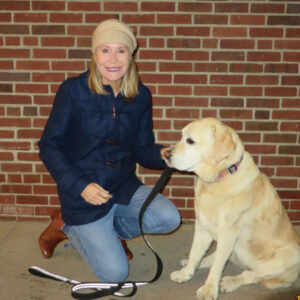You know the look — that puppy-dog-eyed glance. Your dog raises his eyebrows, flashes a fretful face and you stop in your tracks.
You’ll do nearly anything to appease him. Treat? Car ride? Steak? Gucci collar? $500 orthopedic bed?
Recent research reveals that our emotional response to those puppy dog eyes is part of an intense bond between humans and dogs that has likely been in the works for tens of thousands of years.
What are puppy dog eyes?
So, what exactly are puppy dog eyes? “I describe it as (dogs) looking either worried or sad. Just that sad face. They get the wrinkles on the skin of their head,” says Anne Burrows, a biological anthropologist and professor at Duquesne University in Pittsburgh.
We’re drawn to those puppy dog eyes because dogs and humans communicate through eye contact and facial expressions. Researchers say that when dogs and humans lock eyes with one another, there’s an actual physiological reaction that produces what’s called “the love hormone.”
“When humans and dogs gaze into one another’s eyes, both species release that hormone, oxytocin. We don’t seem to do that when we look into the eyes of any other animal. It’s the same hormone that mothers release when they gaze into their newborn baby’s eyes,” Anne says.
Anne and her colleagues wanted to find out what underlays this unique affinity between dogs and humans — and they made some groundbreaking discoveries. “I was beyond excited,” Anne says.
Eyebrow-raising discoveries

/Getty Images
In 2019, the team found that dogs have a facial muscle called the levator anguli oculi medialis, which allows them to make those puppy-dog-eyed looks and raise their eyebrows — but the domesticated dogs’ ancestor, the wolf, does not have that muscle.
“We looked at a variety of dog breeds as well as just mixed breeds,” Anne says. “We found that most dogs we examined have this muscle in their eyebrow region. But we didn’t find it in any of the wolves that we examined.”
Anne’s newest research, released earlier this year, discovered that dogs have significantly more “fast twitch” muscle fibers in their faces than wolves. This allows dogs to make facial expressions rapidly, similarly to how people can quickly change their facial movements.
“Dogs and humans have facial expressions and facial muscles, much more alike than dogs and wolves,” Anne says.
Researchers hypothesize that dogs — that evolved from wolves — developed these characteristics to communicate better with humans.
As a dog lover, Anne knew these discoveries were significant. “We were just so happy because you don’t often have big wins in life. I just came home, and I hugged my dog,” Anne says.
So how did dogs develop these physical traits to capture our hearts with just one look? Let’s rewind about 33,000 years.
The evolution of puppy dog eyes
During the Upper Paleolithic Stone Age period, likely in Siberia and Western Europe, humans were cave-dwellers living in camps among wolves. Scientists theorize that some of the tamer wolves likely started hanging around, hoping to get a scrap of food, and caught the eye of humans who felt an emotional connection to the wolves.
“The friendly wolves probably had the ability to make this puppy dog eye expression and along with that became acceptable to have around your camp,” Anne says. “I think it was just like, ‘This wolf is pretty friendly. Let’s let this one stay with us.’ It just started the process of companionship.”
As these friendlier wolves started breeding, evolving into domesticated dogs, they appeared to have developed the levator anguli oculi medialis muscle and faster twitch facial muscle fibers than wolves. “I think it just accidentally evolved,” Anne says.
The results of the research are raising enthusiastic eyebrows among other scientists.
“I think these findings offer very compelling evidence that dogs have evolved to interact with humans. These findings show how well-adapted dogs are for life in the human social niche: their facial musculature has altered to allow them to be more effective at communicating with people,” says Erin E. Hecht, an assistant professor in the Department of Human Evolutionary Biology at Harvard University.
So the journey of wolves into dogs and the bond between humans and dogs may have started because cave dwellers gazed into some wolves’ eyes, thought they were cute — and it changed the world.
“The evolution of puppy dog eyes is just one more way that dogs have hijacked the bonding pathway that was supposed to be reserved for our babies. I’m not sure there’s anything like it anywhere else in the animal kingdom,” says Brian Hare, a professor of psychology and neuroscience at Duke University.
Humans and dogs evolve together
Anne adds that during the time wolves were domesticating into dogs, they may have also played a role in the evolution of humans.
“Humans became more domesticated themselves,” Anne says. “Our brains became bigger. Men and women stopped being so different in sizes. We started to settle down in one place; instead of these nomadic cave dwellers, you start to see the onset of at least temporary houses that people built.”
The connection shared between dogs and humans possibly impacted both species physically and emotionally. “It’s a deep, strong bond,” Anne says. “We changed one another’s anatomy, one another’s physiology. We changed one another’s brains.”
How puppy dog eyes affect us
Just in case you need confirmation: dogs likely know how to work us over. They have mastered how to catch our eye. They’ve been perfecting that manipulating puppy-dog-eyed look since the Stone Age.
“It seems like the only explanation,” Anne says. “It’s all tied to mutual gaze.”
And that gaze is something dogs reserve just for us. When your dog interacts with other dogs, they mostly communicate through smell, play bows, tail wags and hackling of their fur. “But they don’t use facial expressions with one another the way that they use facial expressions with people,” Anne says.
The next time you hear about someone running into a burning building to save their dog — or a dog that risks his life to rescue his pet parent, it might just be because the 33,000-years-long love affair between the two species has resulted in an attachment like no other.
“People love dogs so much because dogs love us so much,” Anne says. “Dogs just get us in a way that no other animal does.”
(Note: No dogs or wolves were harmed for the purpose of Anne’s studies mentioned in this article.)






